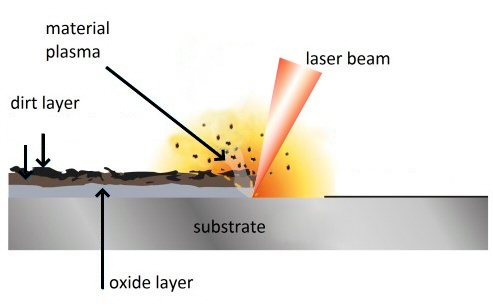What is Laser Cleaning?
Laser Cleaning or Laser ablation is the process of removing material from a solid (or occasionally liquid) surface by irradiating it with a laser beam. At low laser flux, the material is heated by the absorbed laser energy and evaporates or sublimates. At high laser flux, the material is typically converted to plasma. Usually, laser ablation refers to removing material with a pulsed laser, but it is possible to ablate material with a continuous wave laser beam if the laser intensity is high enough. While relatively long laser pulses can heat and thermally alter or damage the processed material, ultrashort laser pulses cause only minimal material damage during processing due to the ultrashort light-matter interaction and are therefore also suitable for micromaterial processing. Excimer lasers of deep ultra-violet light are mainly used in photoablation; the wavelength of the laser used in photoablation is approximately 200 nm.
Application of Laser Cleaning
The simplest application of laser ablation is to remove material from a solid surface in a controlled fashion. Laser machining and particularly laser drilling are examples; pulsed lasers can drill extremely small, deep holes through very hard materials. Very short laser pulses remove material so quickly that the surrounding material absorbs very little heat, so laser drilling can be done on delicate or heat-sensitive materials, including tooth enamel (laser dentistry). Several workers have employed laser ablation and gas condensation to produce nanoparticles of metal, metal oxides and metal carbides.
Another application of laser ablation is to process the material removed into new forms either not possible or difficult to produce by other means. A recent example is the production of carbon nanotubes. Laser cleaning is also used for efficient rust removal from iron objects; oil or grease removal from various surfaces; restoration of paintings, sculptures, frescoes. Laser ablation is one of the preferred techniques for rubber mould cleaning due to minimal surface damage to the mould.
Advantages of Laser Cleaning
- environmentally friendly
- safe to operate
- dry and clean
- highly accurate
- noiseless
- zero-contact
- easy to use
- easy to automate
- safe for any kind of substance, even very delicate surfaces
- high level of control
- no unwanted side effects
- not abrasive or potentially hazardous
- suitable for hard-to-reach areas or surfaces
- suitable for use in dangerous environments
- lower operational costs than most other cleaning techniques
- an absolute minimum number of residue, mostly dust
- minimal maintenance
- quick installation and setup time
Laser Ablation Threshold
The depth over which the laser energy is absorbed, and thus the amount of material removed by a single laser pulse, depends on the material's optical properties and the laser wavelength and pulse length. The total mass ablated from the target per laser pulse is usually referred to as ablation rate. Such features of laser radiation as laser beam scanning velocity and the covering of scanning lines can significantly influence the ablation process.
Since every material has different properties and thus different molecular bonds. Laser energy can be selectively absorbed by coatings, particularly on metal, so CO2 or Nd: YAG pulsed lasers can be used to clean surfaces, remove paint or coating, or prepare surfaces for painting without damaging the underlying surface. In other words, each material has a specific ablation threshold. To successfully remove a layer from a given material, the energy transferred by the laser beam must be above the ablation threshold of that particular material.
This is the laser ablation threshold. Each material has its own specification needed and a layer to overcome in the laser ablation process. Thus, each different material requires a different intensity of the laser to ensure the ablation/cleaning is done properly. If the threshold is not met, this can result in a layer of rust or dirt being left behind and not exposing the underlying layer of the material.
